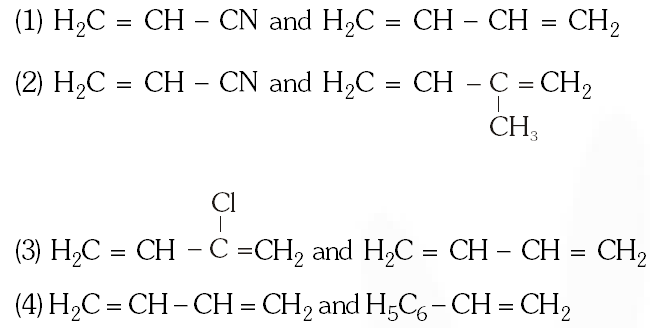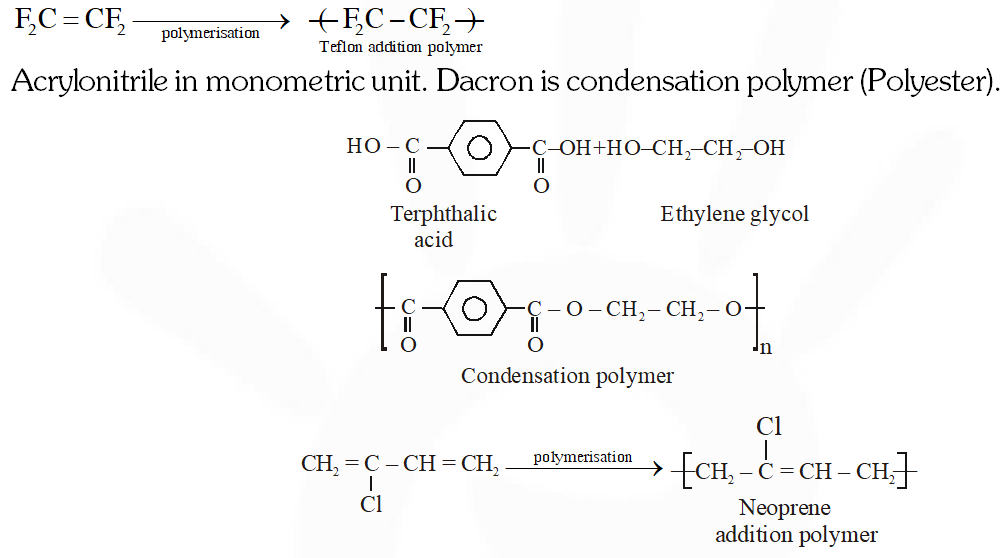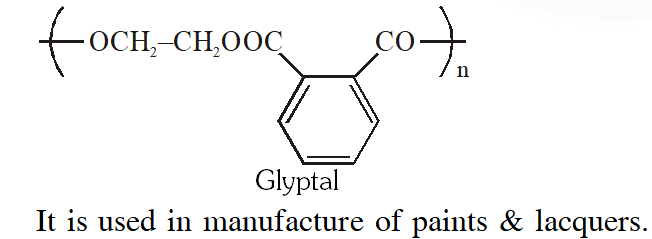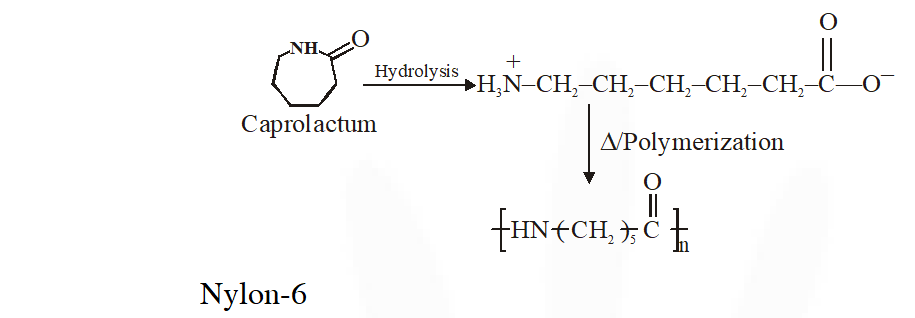JEE Main Previous Year Papers Questions of Chemistry with Solutions are available at eSaral. Practicing JEE Main chapter wise questions of Chemistry will help the JEE aspirants in realizing the question pattern as well as help in analyzing weak & strong areas.
Simulator
Previous Years AIEEE/JEE Main Questions

Q. Buna–N synthetic rubber is a copolymer of :-
 [AIEEE-2009]
[AIEEE-2009]
 [AIEEE-2009]
[AIEEE-2009]
Ans. (1)
Buna-N is actually abbrebiated form, where Bu represents 1, 3-butadiene, Na represents
sodium and N represents nitrile (acrylonitrile).
Thus, Buna-N is a copolymer of 1, 3-butadiene and acrylonitrile usually copolymer of
1, 3-butadiene, and acrylonitrile usually ploymerise in the presence of sodium.
Q. The polymer containing strong intermolecular forces e.g. hydrogen bonding, is :-
(1) natural rubber
(2) teflon
(3) nylon 6, 6
(4) polystyrene
[AIEEE-2010]
Ans. (3)
Q. Thermosetting polymer, Bakelite is formed by the reaction of phenol with :-
(1) $\mathrm{CH}_{3} \mathrm{CH}_{2} \mathrm{CHO}$
(2) $\mathrm{CH}_{3} \mathrm{CHO}$
(3) HCHO
(4) HCOOH
[AIEEE-2011]
Ans. (3)
Bakelite is a thermosetting polymer formed by the condensation reaction of phenol with
HCHO in the presense of conc. $\mathrm{H}_{2} \mathrm{SO}_{4}$
It is thus, a cross-linked polymer in which condesation takes place at O- and p- positions
So HCHO is the corerect option.
Q. The species which can best serve as an initiator for the cationic polymerization is :-
(1) BuLi
 (3) HNO $_{3}$
(4) $\mathrm{AlCl}_{3}$
[AIEEE-2012]
(3) HNO $_{3}$
(4) $\mathrm{AlCl}_{3}$
[AIEEE-2012]
Ans. (4)
Electron - deficient species (Lawis acid) like $\mathrm{AlCl}_{3}, \mathrm{BF}_{3}$ etc.
are is used as initiator for cationic polymerisation.
Q. Which one is classified as a condensation polymer?
(1) Teflon
(2) Acrylonitrile
(3) Dacron
(4) Neoprene
[JEE-Main 2014]
Ans. (3)


Q. Which one of the following structures represents the neoprene polymer :-
 [JEE-Main(Online) - 2015]
[JEE-Main(Online) - 2015]
 [JEE-Main(Online) - 2015]
[JEE-Main(Online) - 2015]
Ans. (3)


Q. Which polymer is used in the manufacture of paints and lacquers ?
(1) Polypropene
(2) Poly vinyl chloride
(3) Bakelite
(4) Glyptal
[JEE- Main - 2015]
Ans. (4)


Q. Which of the following statements about low density polythene is FALSE ?
(1) It is used in the manufacture of buckets, dust-bins etc.
(2) Its synthesis requires high pressure
(3) It is a poor conductor of electricity
(4) Its synthesis requires dioxygen or a peroxide initiator as a catalyst.
[JEE Main 2016]
Ans. (1)
Low density polythene : It is obtained by the polymerisation of ethene under high presure of 1000-2000 atm. at a temp. of 350 K to 570 K in the pressure of traces of dioxygen or a peroxide
Q. Assertion : Rayon is a semisynthetic polymer whose properties are better than
natural cotton.
Reason : Mechanical and aesthetic properties of cellulose can be improved by acetylation.
(1) Both assertion and reason are incorrect
(2) Assertion is incorrect statement, but the reason is correct
(3) Both assertion and reason are correct, but the reason is not the correct explanation for the
assertion
(4) Both assertion and reason are correct, and the reason is the correct explanation for the assertion
[JEE Main (Online) 2016]
Ans. (4)
Q. Which of the following polymers is synthesized using a free radical polymerization
technique ?
(1) Terylene
(2) Teflon
(3) Nylon 6,6
(4) Melamine polymer
[JEE Main (Online) 2016]
Ans. (2)
Q. The formation of which of the following polymers involves hydrolysis reaction ?
(1) Nylon 6
(2) Bakelite
(3) Nylon 6, 6
(4) Terylene
[JEE - Main 2017]
Ans. (1)
Formation of Nylon-6 involves hydrolysis of its monomer (caprolactum) in initial state.


Comments
Anusri@@
March 16, 2021, 10:58 p.m.
Upload more questions pleasee....good app for revision mains concepts
NONE OF THE ABOVE
Aug. 24, 2020, 2:09 p.m.
waste of time...........................................................
Click here to get exam-ready with eSaral
For making your preparation journey smoother of JEE, NEET and Class 8 to 10, grab our app now.
